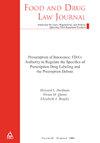第一修正案对强制性言论的限制。
摘要
政府强制的标签要求有着悠久的历史,并被FDA广泛用于监管其管辖范围内的行业。所有这些要求都可以被定性为“强迫言论”的一种形式,为第一修正案的挑战打开了大门。其中一些挑战,取决于标签要求的性质,甚至取得了成功。在Zauderer诉俄亥俄州最高法院纪律顾问办公室一案中,在许多情况下,强制披露信息的规定只需要非常有限的第一修正案审查——甚至比大多数其他商业言论的规定更少,后者接受一种“中间审查”。因此,标签要求可以最好地避免或克服第一修正案的挑战,将遵循佐德尔案中描述的法规的例子。例如,佐德尔运用其较低的审查,指出争议中的强迫言论是“纯粹事实和无争议的信息”的披露。相反,一个成功的第一修正案对标注要求的挑战通常会涉及一个论点,即标注要求超出了Zauderer法院的考虑范围:因此,例如,一个人可能会辩称,强制披露要么“不真实”,要么“有争议”,使其超出了Zauderer的范围。在简要回顾了确立商业言论和强制披露审查水平的主要最高法院案件之后,本文将讨论几个下级法院如何分析Zauderer的各种要素,以及一些法院如何在标签和其他强制性披露法的背景下区分Zauderer。特别是,本文将重点关注涉及第一修正案对食品、烟草和药物标签要求的挑战的案例——有些成功,有些失败,有些正在进行中——包括挑战FDA、USDA和州一级标签要求的案例。已判决的案例并不都同意如何理解Zauderer的要素——例如,披露是否必须在事实上有争议才能不受Zauderer有限的审查,或者它是否在事实上毫无疑问但与有争议的话题有关?如果有的话,公众的接受、知识和历史应该扮演什么角色?政府会援引什么样的利益来证明标签要求的合理性?尽管一些法院已经(或至少暗示)严格限制了Zauderer的含义,但大多数法院都将Zauderer解读为更广泛地适用于超出事实的情况。论文的结论是,一般来说,法院更广泛地解读佐德尔案,部分原因是这样的解读与现有的、熟悉的标签要求是一致的,而对佐德尔案的狭隘解读,限于其事实,将会导致废除许多公认的、历史上未经质疑的标签要求。未来任何扩大对标签要求的司法审查的尝试,都应该强调解决这些问题的限制性原则。Government-mandated labeling requirements have a long history, and are used extensively by FDA in regulating the industries under its jurisdiction. All such requirements can be characterized as a form of “compelled speech,” opening the door to First Amendment challenges. And some of these challenges, depending on the nature of the labeling requirement, have even been successful. Under Zauderer v. Office of Disciplinary Counsel of Supreme Court of Ohio, regulations that compel disclosure of information will, in many cases, merit only very limited First Amendment scrutiny—less, even, than most other regulations of commercial speech, which receive a type of “intermediate scrutiny.” The labeling requirement that can best avoid or overcome a First Amendment challenge, therefore, will follow the example of the regulation described in Zauderer. For example, Zauderer applied its lower scrutiny by noting that the compelled speech at issue was a disclosure of “purely factual and uncontroversial information.” Conversely, a successful First Amendment challenge to a labeling requirement will often involve an argument that the labeling requirement is outside the scope of what the Zauderer Court contemplated: so, for example, one may argue that a compelled disclosure is either “not factual” or else “controversial,” putting it beyond Zauderer’s reach. After briefly reviewing the major Supreme Court cases that establish the levels of scrutiny for commercial speech and compelled disclosures, the paper will discuss how the various elements of Zauderer have been analyzed by several lower courts, and how some courts have distinguished Zauderer in the context of labeling and other mandatory disclosure laws. In particular, the paper will focus on cases involving First Amendment challenges to food, tobacco, and drug labeling requirements—some successful, some not, and some ongoing—including cases challenging FDA, USDA, and state-level labeling requirements. The decided cases do not all agree on how to understand the elements of Zauderer—for example, must a disclosure be factually controversial to fall outside of Zauderer’s limited review, or may it be factually unquestionable but relating to a controversial topic? What role, if any, should public acceptance, knowledge, and history play? What sorts of interests may the government invoke to justify a labeling requirement? Although some courts have taken (or at least hinted at) strict limits on the meaning of Zauderer, most courts have read Zauderer as applying somewhat more expansively to circumstances beyond its facts. The paper concludes that generally, courts have read Zauderer more expansively in part because such a reading is consistent with existing, familiar labeling requirements, and a narrow reading of Zauderer limited to its facts would rest on a slippery slope to abolishing many accepted and historically unquestioned labeling requirements. Any future attempts to expand judicial review of labeling requirements would do well to highlight limiting principles that address such concerns.

 求助内容:
求助内容: 应助结果提醒方式:
应助结果提醒方式:


